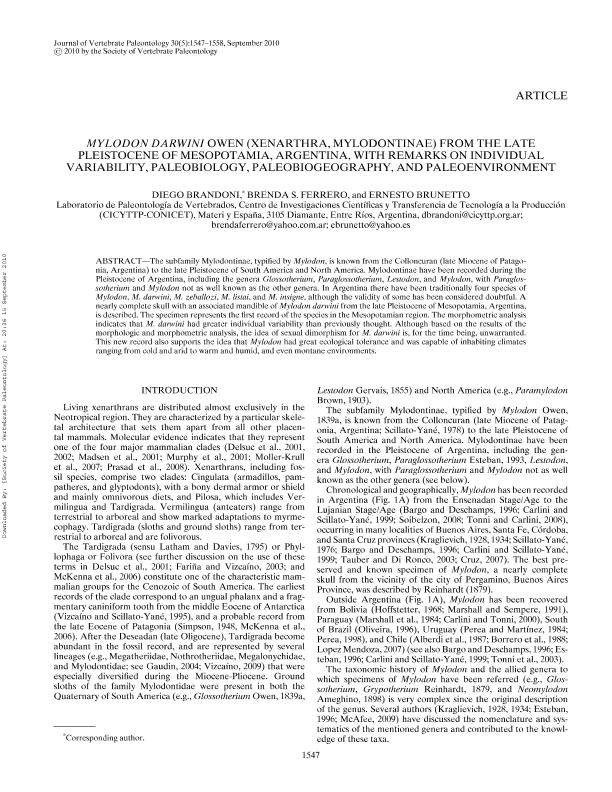Artículo
Mylodon darwini Owen (Xenarthra, Mylodontinae) from the late Pleistocene of Mesopotamia, Argentina, with remarks on individual variability, paleobiology, paleobiogeography, and paleoenvironment
Fecha de publicación:
09/2010
Editorial:
Taylor & Francis
Revista:
Journal of Vertebrate Paleontology
ISSN:
0272-4634
Idioma:
Inglés
Tipo de recurso:
Artículo publicado
Clasificación temática:
Resumen
The subfamily Mylodontinae, typified by Mylodon, is known from the Colloncuran (late Miocene of Patagonia, Argentina) to the late Pleistocene of South America and North America. Mylodontinae have been recorded during the Pleistocene of Argentina, including the genera Glossotherium, Paraglossotherium, Lestodon, and Mylodon, with Paraglossotherium and Mylodon not as well known as the other genera. In Argentina there have been traditionally four species of Mylodon, M. darwini, M. zeballozi, M. listai, and M. insigne, although the validity of some has been considered doubtful. A nearly complete skull with an associated mandible of Mylodon darwini from the late Pleistocene of Mesopotamia, Argentina, is described. The specimen represents the first record of the species in the Mesopotamian region. The morphometric analysis indicates that M. darwini had greater individual variability than previously thought. Although based on the results of the morphologic and morphometric analysis, the idea of sexual dimorphism for M. darwini is, for the time being, unwarranted. This new record also supports the idea that Mylodon had great ecological tolerance and was capable of inhabiting climates ranging from cold and arid to warm and humid, and even montane environments.
Archivos asociados
Licencia
Identificadores
Colecciones
Articulos(CICYTTP)
Articulos de CENTRO DE INV.CIENT.Y TRANSFERENCIA TEC A LA PROD
Articulos de CENTRO DE INV.CIENT.Y TRANSFERENCIA TEC A LA PROD
Citación
Brandoni, Diego; Ferrero, Brenda Soledad; Brunetto, Ernesto; Mylodon darwini Owen (Xenarthra, Mylodontinae) from the late Pleistocene of Mesopotamia, Argentina, with remarks on individual variability, paleobiology, paleobiogeography, and paleoenvironment; Taylor & Francis; Journal of Vertebrate Paleontology; 30; 5; 9-2010; 1547-1558
Compartir
Altmétricas




